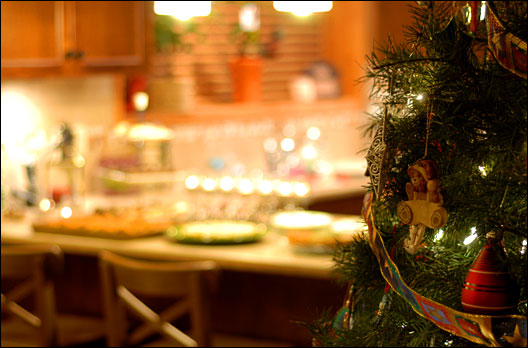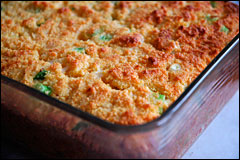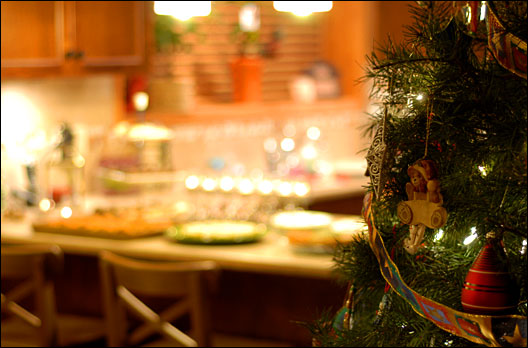
This is the holiday season in just about every culture. I was born and raised a Unitarian Universalist, thus of the Judeo-Christian background, so in my house it’s Christmastime. For some folks, Christmas is about peace and good tidings. For others it is a joyous celebration of the birth of their savior. In my family it was, and still is, all about the food. It’s about presence rather than presents.
There are many items that must be on the table, or else it simply is not Christmas. Among these are the clam dip, the wild-rice dressing, grandma’s cranberries, and mom’s bourbon pound cake. I’ve shared all these recipes before in this space and others, save the pound cake, which is a very closely guarded family recipe. The secret is to … nope, still not going to tell you. I will say this, however: Last year my mother learned that you can’t make up for not having the last 3/4 cup of all-purpose flour by replacing it with 3/4 cup of bread flour — unless making a doorstop is your intended result.
My wife Kim’s family had different food traditions, including oyster stew and tamales (odd for her Scots-German heritage) as well as some more Midwest-conventional items like green bean casserole and a lemon Jell-O mold of pineapples and carrots that was on every holiday table at her grandmother’s home in Decorah, Iowa. But the best tradition of her family, and the one that made it so easy for us to combine our holiday traditions when we married more than 20 years ago, was cornbread and beans.
Kim’s mother and grandmother both used Jiffy Mix for their cornbread, but Kim married a chef, so now we make it from scratch every Christmas Eve. We are all the more grateful for the rich and luxurious feast on Christmas Day, which offers a counterpoint of good fortune alongside the prior night’s nod of respect to a time not so long ago when our families could afford no more than cornbread and beans for their holiday supper. We must always remember that our family was not always so fortunate, and tomorrow once again may not be.
Our cornbread ritual is also intended as a symbolic reminder of the far-too-numerous people in this country and around the world who are, as the current vernacular would have it, “food insecure.” Through Slow Food, much of my time is occupied with these issues. My kids, however, have grown up never knowing the fear of wondering where their next meal would come from. I was fortunate enough to grow up the same way. But my father was born to immigrants during the Great Depression, and that experience influenced much more about the family than simply making it frugal.
The tradition in which I was raised teaches of the inherent worth and dignity of every person, and also of justice, equity, and compassion in human relations; lessons preached by nearly every religious belief in one way or another. But learning these lessons and applying them are different matters. To apply them we must do more than simply see that there are a billion people starving in the world and a billion more paradoxically overweight and undernourished. We must insist that something be done. To that end we donate time, money, and resources, and we advocate for change on a local, national, and global level. One example of an organization we support, one we hope to help spread nationwide, is Local Foods Connection.
This innovative approach uses a number of techniques to provide CSA shares to underprivileged families. They do more than merely supplying fresh food, though. They provide education on how to prepare it, how to grow it at home, where it comes from, and why it’s better for you. Families visit the farms and participate from plant to plate. Imagine the impact if this idea were to spread nationwide: struggling families receiving healthful, locally produced food instead of empty calories.
So many people are focused on their own finances, their own concerns, wondering how to get the Wii console when they don’t know if they’ll be employed next month. While I believe firmly that the philosophy we all learn on airplanes — put on your own oxygen mask before helping those around you — can be useful in everyday life, sometimes the right thing to do is reach out and help others no matter what your own situation may be. That might be as simple as inviting someone to your table for some cornbread and beans.
Like all good holiday traditions, the ritual of production, presentation, and consumption must be adhered to in order to experience the full effect. The cornbread must be served warm, sliced horizontally, and spread with butter (not margarine). The beans must be navy beans, cooked simply in salted water, and ladled piping hot over the buttered cornbread. The dish is then garnished with diced yellow onions, hand-chopped pickled hot peppers, and white vinegar.
The only exception to this rule belonged to Kim’s brother Scott, who since he was a toddler refused the cornbread and beans, so his doting grandmother made macaroni and cheese for him. Today homemade mac-and-cheese is an odd, starchy, but satisfying side dish on our Christmas Eve table.
Iowa Cornbread
Though it divides in half easily, this cornbread recipe makes a large batch, because I hope plenty of family and many friends surround your holiday table.

1 cup all-purpose flour
1/4 cup sugar
2 teaspoons salt
4 teaspoons baking powder
1 teaspoon baking soda
2 eggs, beaten
3 cups buttermilk (or 2 3/4 cup milk plus 3 tablespoons vinegar)
1/2 cup butter or lard, melted
1/2 cup Monterey jack cheese, shredded, optional
4 scallions, sliced, optional
Preheat oven to 425 F and grease a Pyrex dish (8″ x 10″ x 4″ or equivalent).
Combine all dry ingredients thoroughly in a large mixing bowl. Separately combine the beaten egg, buttermilk, and melted butter or lard. Add the liquid to the dry (and add the cheese and scallions, if desired) and fold to combine until just evenly moist.
Spoon the mixture into the greased dish and bake in center of oven for 30 minutes or until a toothpick inserted into the center of the bread comes out clean.
Allow to stand 15 minutes before serving. Makes 10-12 healthy portions.



